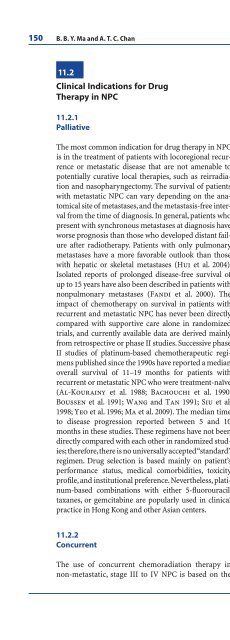Familial Nasopharyngeal Carcinoma 6
Familial Nasopharyngeal Carcinoma 6
Familial Nasopharyngeal Carcinoma 6
- No tags were found...
You also want an ePaper? Increase the reach of your titles
YUMPU automatically turns print PDFs into web optimized ePapers that Google loves.
150 B. B. Y. Ma and A. T. C. Chan11.2Clinical Indications for DrugTherapy in NPC11.2.1PalliativeThe most common indication for drug therapy in NPCis in the treatment of patients with locoregional recurrenceor metastatic disease that are not amenable topotentially curative local therapies, such as reirradiationand nasopharyngectomy. The survival of patientswith metastatic NPC can vary depending on the anatomicalsite of metastases, and the metastasis-free intervalfrom the time of diagnosis. In general, patients whopresent with synchronous metastases at diagnosis haveworse prognosis than those who developed distant failureafter radiotherapy. Patients with only pulmonarymetastases have a more favorable outlook than thosewith hepatic or skeletal metastases (Hui et al. 2004).Isolated reports of prolonged disease-free survival ofup to 15 years have also been described in patients withnonpulmonary metastases (Fandi et al. 2000). Theimpact of chemotherapy on survival in patients withrecurrent and metastatic NPC has never been directlycompared with supportive care alone in randomizedtrials, and currently available data are derived mainlyfrom retrospective or phase II studies. Successive phaseII studies of platinum-based chemotherapeutic regimenspublished since the 1990s have reported a medianoverall survival of 11–19 months for patients withrecurrent or metastatic NPC who were treatment-naïve(Al-Kourainy et al. 1988; Bachouchi et al. 1990;Boussen et al. 1991; Wang and Tan 1991; Siu et al.1998; Yeo et al. 1996; Ma et al. 2009). The median timeto disease progression reported between 5 and 10months in these studies. These regimens have not beendirectly compared with each other in randomized studies;therefore, there is no universally accepted “standard”regimen. Drug selection is based mainly on patient’sperformance status, medical comorbidities, toxicityprofile, and institutional preference. Nevertheless, platinum-basedcombinations with either 5-fluorouracil,taxanes, or gemcitabine are popularly used in clinicalpractice in Hong Kong and other Asian centers.11.2.2ConcurrentThe use of concurrent chemoradiation therapy innon-metastatic, stage III to IV NPC is based on therationale that chemotherapy may control micrometastasesand can act as a radiosensitizer. To date, atleast eight phase III studies comparing radiotherapyalone vs. concurrent chemoradiation have been publishedfrom centers in both endemic and non-endemicregions (Al-Sarraf et al. 1998; Chan et al. 2002; Linet al. 2003; Wee et al. 2005; Lee et al. 2005, 2006;Kwong et al. 2004; Zhang et al. 2005). The concurrentregimens used in these studies varied in terms ofthe choice of drugs (i.e., platinum (Al-Sarraf et al.1998; Chan et al. 2002; Lin et al. 2003; Wee et al. 2005;Lee et al. 2005; Zhang et al. 2005) or non-platinum(Kwong et al. 2004) ), schedule (e.g., weekly low-dosecisplatin (Chan et al. 2002), 3-weekly high-dose cisplatin(Al-Sarraf et al. 1998; Chan et al. 2002; Weeet al. 2005; Lee et al. 2005, 2006; Kwong et al. 2004;Zhang et al. 2005), or a cisplatin-based two-drugregimen (Lin et al. 2003) ). In spite of these differences,these studies unanimously reported a statisticallysignificant improvement in progression-freesurvival (or failure-free survival) and/or overall survivalfavoring the chemoradiation arm than theradiotherapy alone. Two meta-analyses have reportedthat concurrent chemoradiation reduces the risk ofdeath in non-metastatic stage III and IV NPC byaround 40%–52%, and reduces the risk of distant failureby 28% (Baujat et al. 2006; Langendijk et al.2004). It should be noted that concurrent chemoradiationcan exacerbate the acute and late toxicities ofradiotherapy including radiation mucositis, ototoxicity,and other soft tissue damage (Lee et al. 2005).Researchers from the Prince of Wales Hospitaland Queen Elizabeth Hospital in Hong Kong publishedthe first completed Asian phase III study, where350 patients with non-metastatic, AJCC stage IIB toIV NPC were randomized to radiotherapy (66 Gy plusa 10–20 Gy parapharyngeal boost) with or withoutconcurrent weekly cisplatin (40 mg/m 2 /week) forseven cycles. At a median follow-up of 5.5 years, theconcurrent arm was associated with a non-statisticallysignificant trend toward an improved overall(p = 0.05) and progression-free survival (p = 0.06).However, in a subgroup analysis, a statistically significantimprovement in overall (p = 0.01) and progression-free(p = 0.01) survival was reported inpatients with T3–T4 tumors. No difference in distantand local recurrence rates was identified in this study(Chan et al. 2005). Since the mid-1990s, this protocolhas been adopted for routine practice at the Departmentof Clinical Oncology, Prince of Wales Hospital,where the current standard of care for patients withnon-metastatic NPC that are stage IIB, stage III orIVB, is to offer intensity-modulated radiotherapy











